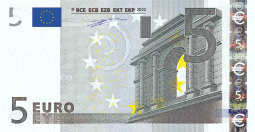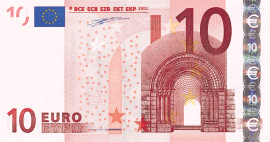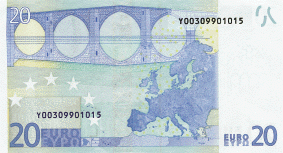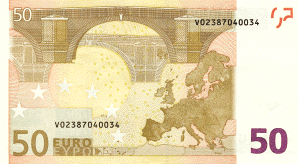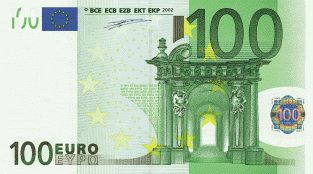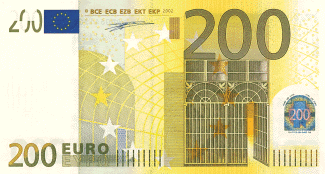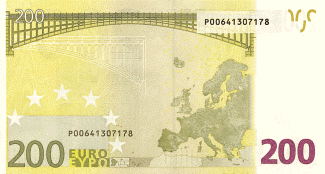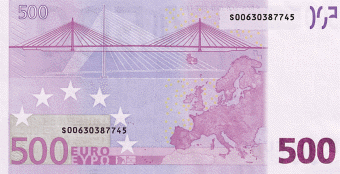Euro banknotes
|
|

The euro (EUR or €) is the single currency for many countries within the European Union. The euro was formally established as a unit of exchange on 1 January, 1999, and euro banknotes and coins (see euro coins) entered circulation on 1 January, 2002.
| Contents |
Denominations
There are seven different denominations, each having a distinctive colour and size. The design for each of them has a common theme of European architecture in various artistic periods. The front (or recto) of the note features windows or gateways while the back (or verso) has bridges. Care has been taken so that the architectural examples do not represent any actual existing monument, so as not to induce jealousy and controversy in the choice of which monument should be depicted.
Common to all notes are the European flag, the initials of the European Central Bank in five versions (BCE, ECB, EZB, ΕΚΤ, EKP), a map of Europe on the back, the name "euro" in both Latin and Greek script and the signature of the current president of the ECB. The 12 stars of the EU are also incorporated into every note, with the first design having been created by Austrian artist Robert Kalina.
Banknote pictures
| Denomination | Dimensions | Dominant Colour | Architecture | Period | Printercode position |
|---|---|---|---|---|---|
| 5 euro | €5 | 120 x 62 mm |
Grey |
< 5th century |
left image edge (http://www.eurotracer.net/information/notes.php?type=f5) |
|
| 10 euro | €10 | 127 x 67 mm |
Red |
11-12th centuries |
8 o'clock star (http://www.eurotracer.net/information/notes.php?type=f10) |
|
| 20 euro | €20 | 133 x 72 mm |
Blue |
13-14th centuries |
9 o'clock star (http://www.eurotracer.net/information/notes.php?type=f20) |
|
| 50 euro | €50 | 140 x 77 mm |
Orange |
15-16th centuries |
right image edge (http://www.eurotracer.net/information/notes.php?type=f50) |
|
| 100 euro | €100 | 147 x 82 mm |
Green |
17-18th centuries |
right of 9 o'clock star (http://www.eurotracer.net/information/notes.php?type=f100) |
|
| 200 euro | €200 | 153 x 82 mm |
Yellow-brown |
Iron & Glass |
19-20th centuries |
above 7 o'clock star (http://www.eurotracer.net/information/notes.php?type=f200) |
| 500 euro | €500 | 160 x 82 mm |
Purple |
20-21st centuries |
9 o'clock star (http://www.eurotracer.net/information/notes.php?type=f500) |
The following member overseas territories are shown: the Azores, French Guyana, Guadeloupe, Madeira, Martinique, Réunion, and the Canary Islands. Cyprus and Malta are not shown — they only joined the EU in 2004; also Malta is also too small to be shown, with the minimum size for depiction being 400km².
Security features
The ECB has described some of the more rudimentary security features of the euro note, allowing the general public to authenticate their currency at a glance. However, in the interest of security, the exhaustive list of these features is a closely-guarded secret.
Still, between the official descriptions and independent discoveries made by observant users, it is thought that the euro notes include at least thirty different security features. These include:
Holograms: the €5, €10 and €20 notes carry a holographic band to the right of the front side. This band is imprinted with the note's denomination; e.g., "€5 €5 €5...." in the case of the five-euro note.
In the case of the €50 notes and higher, the band is replaced with a holographic decal.
Variable colour ink appears on the lower right corner of back side of the €50 and higher. When observed from different angles, the colour varies between purple and green.
Checksum: each note has a unique serial number. The serial number is validated using a checksum. The following is an extract from the europa.union.euro FAQ that explains how to check the validity of a serial number:
- Replace the initial letter by its position in the alphabet (that is L is 12, M is 13,..., Z is 26).
- Add up this number and every digit of the serial number. For example:
- U08217383936 is 21 + 0 + 8 + 2 + 1 + 7 + 3 + 8 + 3 + 9 + 3 + 6 = 71
- Add up all the digits of this new number, redo as many times as necessary until you obtain a one-digit number.
The resulting number must be 8 — in the example above, 7 + 1 = 8, so it's correct.
Watermark: Each denomination is printed on uniquely-watermarked paper. This may be observed by holding the note up to the light.
Registration: The note denomination in the upper-left corner of the front of each note is printed incompletely, as is the denomination in the upper-right corner of the back. When held up to the light, this denomination is visible in its entirety. Genuine notes will exhibit perfect alignment (or 'registration') between the front and back. If the note has been printed incorrectly, i.e. by a counterfeiter, these numbers may appear poorly aligned.
Texture: some areas of the notes have a different texture from others. the BCE ECB EZB text is one of them.
Bar code: when held up to the light, metallic bars can be seen to the right of the watermark. The number and width of these bars indicates the value of the note. When scanned, these bars are converted to Manchester code.
| Note | Barcode | Manchester |
| €5 | 0110 10 | 100 |
| €10 | 0101 101 | 110 |
| €20 | 1010 1010 | 0000 |
| €50 | 0110 1010 | 1000 |
| €100 | 0101 1010 | 1100 |
| €200 | 0101 0110 | 1110 |
| €500 | 0101 0101 | 1111 |
EURion constellation: Euro banknotes contain a pattern known as the EURion constellation which can be used to detect their identity as banknotes to prevent copying. Many colour photocopiers are programmed to reject images containing this pattern. Recent versions of image editors, such as Adobe Photoshop or Paint Shop Pro also refuse to process banknotes. However, experiments by Steven J. Murdoch and others showed that this banknote detection code does not rely on the EURion pattern. It detects other features of banknote designs that have yet to be described in public.
Security Thread: A black thread in the middle of the note is seen only against a light source. It shows the denomination of the note, along with the word "euro". This thread is magnetic.
Magnetic ink: Some areas feature magnetic ink. The rightmost church window on the €20 note is magnetic, as well as the large zero above it.
Infra-red and ultra-violet watermarks: when seen in the near infrared, the banknotes will show darker areas in different zones depending on the denomination. Ultraviolet light will make the EURion constellation show in sharper contrast, and also some fluorescent threads stand out.
Micro-print: the texture lines to the bottom, e.g. those aligned with the ΕΥΡΩ mark on the 10 EUR note, are actually made of the word "EURO" in very small print.
Matted surface: the EURO symbol and the denomination are printed on a vertical band which is only visible when lighted at an angle of 45°.
Serial Number
Unlike the euro coins, the euro notes do not have a national side indicating where they're from. This information is instead encoded within the note's serial number.
The first letter of the serial number uniquely identifies the country that issues the note. The remaining numbers (when added up and the digits of the resulting sum then added together again until a single digit remains) give a checksum also particular to that country. The W, K and J codes have been reserved for the EU member states currently not participating in the euro.
Country letters
| Code | Country | Checksum |
|---|---|---|
Z |
Belgium | 9 |
Y |
Greece | 1 |
X |
Germany | 2 |
(W) |
(Denmark) | (3) |
V |
Spain | 4 |
U |
France | 5 |
T |
Ireland | 6 |
S |
Italy | 7 |
R |
Luxembourg | 8 |
(Q) |
Not Used | (9) |
P |
Netherlands | 1 |
(O) |
Not Used | (2) |
N |
Austria | 3 |
M |
Portugal | 4 |
L |
Finland | 5 |
(K) |
(Sweden) | (6) |
(J) |
(United Kingdom) | (7) |
The notes of Luxembourg currently use the prefix belonging to the country where they were printed. Country codes are alphabetised according to the countries' names in the official language of each country, but reversed:
- United Kingdom
- Sverige
- Suomi
- Portugal
- Österreich [Oesterreich]
- Nederland
- Luxembourg
- Italia
- Ireland
- France
- España [Espana]
- Ελλάδα [Ellada]
- Deutschland
- Danmark
- België [Belgie]/Belgique
The positions of Denmark and Greece have been swapped in the list of letters starting the serial numbers, presumably because 'Y' is a letter of the Greek alphabet, while 'W' is not. Also, only official languages which are also official EU languages were used. For example Ireland's first official language is Irish, however in the above chart it is clear the order was based on the English Ireland rather than the Irish which is Éire.
Printing works
Somewhat hidden on the front of the note is a second, smaller sequence where the first letter identifies the actual printer of the note. The printer code need not coincide with the country code, i.e. notes issued by a particular country may have been printed in another country (e.g. some Finnish notes have in fact been produced by a UK printer). The A, C and S codes have been reserved for printers currently not printing euro banknotes.
| Code | Printer | Location | Country |
|---|---|---|---|
(A) |
(Bank of England Printing Works) | (Loughton) | (United Kingdom) |
(B) |
Not Used | --- | --- |
(C) |
(Tumba Bruk) | (Tumba) | (Sweden) |
D |
Setec Oy | Vantaa | Finland |
E |
F. C. Oberthur | Chantepie | France |
F |
Österreichische Banknoten und Sicherheitsdruck | Vienna | Austria |
G |
Johan Enschedé & Zn. | Haarlem | Netherlands |
H |
De La Rue | Gateshead | United Kingdom |
(I) |
Not Used | --- | --- |
J |
Banca d'Italia | Rome | Italy |
K |
Central Bank of Ireland | Dublin | Ireland |
L |
Banque de France | Chamalières | France |
M |
Fábrica Nacional de Moneda y Timbre | Madrid | Spain |
N |
Bank of Greece | Athens | Greece |
(O) |
Not Used | --- | --- |
P |
Giesecke & Devrient | Munich & Leipzig | Germany |
(Q) |
Not Used | --- | --- |
R |
Bundesdruckerei | Berlin | Germany |
(S) |
(Danmarks Nationalbank) | (Copenhagen) | (Denmark) |
T |
National Bank of Belgium | Brussels | Belgium |
U |
Valora - Banco de Portugal | Carregado | Portugal |
As from 2002, the individual national central banks (NCBs) are responsible for the production of one or two specific banknote denominations and will thus select the printing works. This decentralised pooling scheme means that the NCBs have to exchange the denominations produced in different locations prior to issue.
Design changes and smaller euro denominations
Italy, Greece and Austria have asked several times to introduce lower denominations of euro notes. The ECB has stated that "printing a €1 note is more expensive (and less durable) than minting a €1 coin". On 18 November 2004 the ECB decided definitively that there was insufficient demand across the Eurozone for very low denomination banknotes.
The design of the banknotes did not change after the expansion of the European Union to the east in 2004 (for example, the map does not show Cyprus). Additionally, after Bulgaria joins the EU, the banknotes will have to be updated with a cyrillic rendering of the name "Euro". Newer designs will likely be issued at the end of the decade. Like the pre-euro currencies, the new series will start from the lower denominations.
Banknotes have to bear the ECB president's signature. New notes printed after November 2003 show Jean Claude Trichet's signature, replacing that of the first president, Wim Duisenberg.
External links
- Rejected designs for the Euro banknotes (http://www.admirabledesign.com/rubrique.php3?id_rubrique=98)
- European Central Bank (http://www.euro.ecb.int)
- ECB euro notes and coins FAQ (http://www.ecb.int/bc/html/index.en.html)
- EuroBillTracker (http://www.eurobilltracker.com/)
- Eurotracer (http://www.eurotracer.net/)
- Track your Euros at WhereAreMyEuros.com! (http://www.WhereAreMyEuros.com/)
- myeuro.info (http://www.myeuro.info/)
- newsgroup <europa.union.euro> (news:europa.union.euro)da:Eurosedlerne de:Eurobanknoten it:Banconote Euro lb:Eurobilljetënnl:Eurobankbiljetten ro:Bancnote euro sv:Eurosedlar

